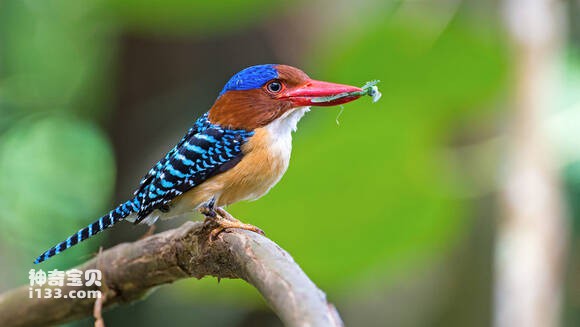Lacedo pulchella
IUCN
LCBasic Information
Scientific classification
- name:Lacedo pulchella
- Scientific Name:Lacedo pulchella,Banded Kingfisher
- Outline:Climbing birds
- Family:
Vital signs
- length:About 20 cm
- Weight:No textual research information is available
- lifetime:No textual research information is available
Feature
Distribution and Habitat
It is distributed in Indochina Peninsula and southeast coastal areas of China.
The barred kingfisher lives in the rainforests of Borneo, generally ranging from sea level to 625 m above sea level and often exceeding 800 m in height. Like many other game kingfishers, they do not depend on rivers and ponds in their forest habitat.
Appearance
The barred kingfisher is 20 cm long. The adult male's forehead, eyes, cheeks and collar are clearly defined by a bright brown color. The crown is covered with blue-purple feathers with a black base. The tail has a blue base and is separated by about 6 small blue stripes.
Nestlings and chicks are black with only 2 white stripes. Chin and throat are white. The chest, two wings, and subtail have an orange transition area, but the middle belly is white. The underside of the wings is pale yellow. Powerful red beak, yellow-brown irises, lotus brown legs.
Male and female have different plumage. The red and black tops of adult females are very distinct. The tail is closely spaced with 6 black lines. The throat and chin are white. The rest of the lower body is white or pale yellow, and the chest and wings are black and white.
Details
It is known as Lacedo pulchella and has three subspecies。

The song of the barred kingfisher is a long series of whistles "ouiiiou", followed by 15 short hisses after a short 17-second interval, then shortening the first syllable and fading away in the last two syllables.
Barred kingfishers usually live alone or in couples in the shade of tropical rainforests. They have a strong sense of territorial defense and are more active during the breeding season. This is a completely carnivorous kingfisher. The main food is locusts, orthoptera crickets, cicadas, stick insects, beetles and larvae, and small lizards are also caught.
Barred kingfishers nest in tree trunks 3 meters above the ground, usually using termites to eat empty holes in the tree. Two to five eggs are laid at a time. Breeding times vary from place to place, with February and May in Thailand, May in Sumatra and Java, and March to January in Borneo.
Listed in the International Union for Conservation of Nature (IUCN) ver 3.1:2008 Red List of Birds: Not threatened.
Protect wild animals and eliminate wild meat.
Maintaining ecological balance is everyone's responsibility!








